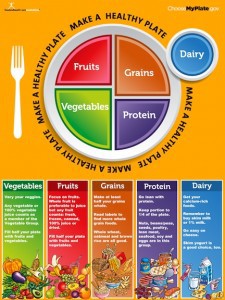
Currently, about half of all American adults have one or more chronic diseases, many of which are associated with poor dietary intake and lack of physical activity. The Dietary Guidelines for Americans is a resource that provides nutrition and dietary advice designed to help Americans achieve and maintain a healthy body weight, meet nutrient needs, and reduce the risk of diet-related chronic diseases. Every five years, a new edition of the Dietary Guidelines is published. A committee of researchers in the fields of nutrition, health, and medicine develop this document through the analysis and evaluation of current scientific evidence.
The 2015-2020 Dietary Guidelines for Americans emphasize the importance of following a healthy eating pattern. An eating pattern is the combination of foods and beverages that make up a person’s dietary intake over time. A healthy eating pattern includes:
Vegetables, a variety including dark green, red and orange, legumes (beans and peas), starchy, and other subgroups
Fruits, especially whole fruits
Grains, at least half of which are whole grains
Dairy, fat-free or low-fat, including milk, yogurt, cheese
Protein foods, a variety including seafood, lean meats and poultry, eggs, legumes (beans and peas), and nuts, seeds, and soy products
Oils, including those from plants such as canola, corn, olive, peanut, safflower, soybean, and sunflower; oils are also naturally present in nuts, seeds, seafood, olives, and avocados
A healthy eating pattern limits saturated fat, trans fat, refined starches, added sugars, and sodium. Keep in mind that improving your eating pattern and lifestyle doesn’t have to happen overnight. Start with small shifts in food choices. For example, try shifting from: white bread to whole wheat, full-fat cheese to low-fat, soft drinks to water, potato chips to unsalted nuts, and butter to olive or canola oil. A healthy eating pattern should be paired with appropriate levels of physical activity. Adults need at least 150 minutes of physical activity each week, and children ages 6 to 17 years need at least 60 minutes of physical activity per day.
For more information on an eating pattern specific to your body’s needs, contact a local registered dietitian or healthcare professional.
-Written by Amanda Berckes, SDSU Dietetic Intern

